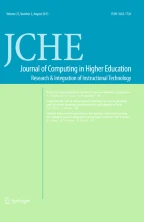Abstract
This study examines factors associated with the use of learning technologies by higher education faculty. In an online survey in a UK university, 114 faculty respondents completed a measure of Internet self-efficacy, and reported on their use of learning technologies along with barriers to their adoption. Principal components analysis suggested two main barriers to adoption: structural constraints within the University and perceived usefulness of the tools. Regression analyses indicated both these variables, along with Internet self-efficacy, were associated with use of online learning technology. These findings are more consistent with models of technology engagement that recognize facilitating or inhibiting conditions (unified theory of acceptance and use of technology; decomposed theory of planned behavior) than the classic technology acceptance model (TAM). Practical implications for higher education institutions are that while faculty training and digital literacy initiatives may have roles to play, structural factors (e.g., provision of resources and technical support) must also be addressed for optimal uptake of learning technologies.
Similar content being viewed by others
Explore related subjects
Discover the latest articles, news and stories from top researchers in related subjects.References
Ajjan, H., & Hartshorne, R. (2008). Investigating faculty decisions to adopt Web 2.0 technologies: Theory and empirical tests. The Internet and Higher Education, 11(2), 71–80. doi:10.1016/j.iheduc.2008.05.002.
Ajzen, I., & Fishbein, M. (1980). Understanding attitudes and predicting social behavior. Englewood Cliffs, NJ: Prentice-Hall.
Bagozzi, R. P. (2007). The legacy of the technology acceptance model and a proposal for a paradigm shift. Journal of the Association for Information Systems, 8(4), 243–254. Retrieved from http://aisel.aisnet.org/jais/vol8/iss4/12/.
Bandura, A. (1977). Self-efficacy: Toward a unifying theory of behavioral change. Psychological Review, 84(2), 191–215. doi:10.1037/0033-295X.84.2.191.
Davis, F. D. (1989). Perceived usefulness, perceived ease of use, and user acceptance of information technology. MIS quarterly, 13(3), 319–340. doi:10.2307/249008.
Davis, F. D. (1993). User acceptance of information technology: System characteristics, user perceptions and behavioral impacts. International Journal of Man-Machine Studies, 38(3), 475–487. doi:10.1006/imms.1993.1022.
Eastin, M. S., & LaRose, R. (2000). Internet self-efficacy and the psychology of the digital divide. Journal of Computer-Mediated Communication, 6(1). doi:10.1111/j.1083-6101.2000.tb00110.x.
Horn, J. (1965). A rationale and test for the number of factors in factor analysis. Psychometrika, 30(2), 179–185. doi:10.1007/BF02289447.
Hsu, M.-H., & Chiu, C.-M. (2004). Internet self-efficacy and electronic service acceptance. Decision Support Systems, 38(3), 369–381. doi:10.1016/j.dss.2003.08.001.
Lean, J., Moizer, J., Towler, M., & Abbey, C. (2006). Simulations and games. Active Learning in Higher Education, 7(3), 227–242. doi:10.1177/1469787406069056.
McKenna, K. Y. A., Green, A. S., & Gleason, M. E. J. (2002). Relationship formation on the internet: What’s the big attraction? Journal of Social Issues, 58(1), 9–31. doi:10.1111/1540-4560.00246.
Park, N., Lee, K. M., & Cheong, P. H. (2008). University instructors’ acceptance of electronic courseware: An application of the technology acceptance model. Journal of Computer-Mediated Communication, 13(1), 163–186. doi:10.1111/j.1083-6101.2007.00391.x.
Patil, V. H., Singh, S. N., Mishra, S., & Donavan, D. T. (2008). Efficient theory development and factor retention criteria: Abandon the ‘eigenvalue greater than one’ criterion. Journal of Business Research, 61(2), 162–170. doi:10.1016/j.jbusres.2007.05.008.
Taylor, S., & Todd, P. A. (1995). Understanding information technology usage: A test of competing models. Information Systems Research, 6(2), 144–176. doi:10.1287/isre.6.2.144.
Torkzadeh, G., & Van Dyke, T. P. (2002). Effects of training on Internet self-efficacy and computer user attitudes. Computers in Human Behavior, 18(5), 479–494. doi:10.1016/S0747-5632(02)00010-9.
Venkatesh, V., Morris, M. G., Davis, G. B., & Davis, F. D. (2003). User acceptance of information technology: Toward a unified view. MIS quarterly, 425–478. Retrieved from http://www.jstor.org/stable/30036540.
Yi, M. Y., & Hwang, Y. (2003). Predicting the use of web-based information systems: Self-efficacy, enjoyment, learning goal orientation, and the technology acceptance model. International Journal of Human-Computer Studies, 59(4), 431–449. doi:10.1016/S1071-5819(03)00114-9.
Acknowledgments
We gratefully acknowledge the assistance of Li Jin and Federica Oradini with some aspects of this project.
Author information
Authors and Affiliations
Corresponding author
Rights and permissions
About this article
Cite this article
Buchanan, T., Sainter, P. & Saunders, G. Factors affecting faculty use of learning technologies: implications for models of technology adoption. J Comput High Educ 25, 1–11 (2013). https://doi.org/10.1007/s12528-013-9066-6
Published:
Issue Date:
DOI: https://doi.org/10.1007/s12528-013-9066-6
